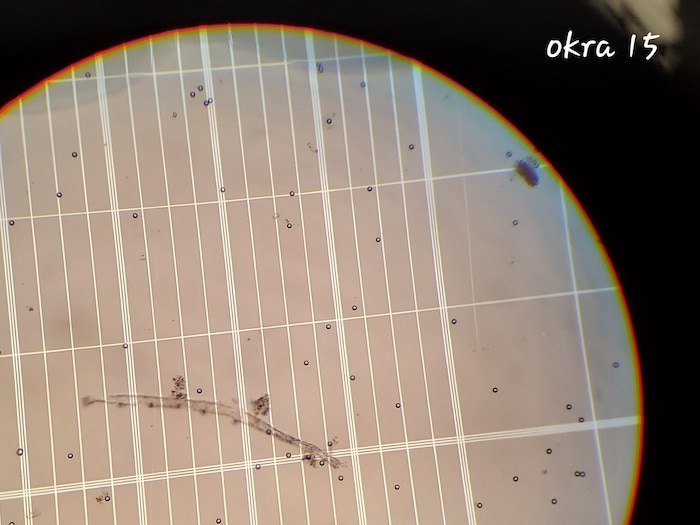
Okra Goo: The New Secret Weapon in the Battle Against Microplastics

Scientists have a new weapon in the fight against microplastics, and it’s something you probably wouldn’t expect: okra goo. Turns out, what makes the insides of okra slimy also cause it to bind to tiny plastic particles. If commercialized and added to existing water treatment procedures, use of the plant extract could result in wide-ranging health and environmental benefits.
Microplastics are 5 mm (0.19-inch) or smaller, The Guardian reported. Microplastics enter our water sources (including ocean water, estuary water, freshwater, groundwater and even wastewater) and then sneak into our bodies.
According to the report, the health effects of ingesting microplastics are currently unclear, though microplastic pollution has been found in human organs and, most recently, in our bloodstream. An older study found that microplastics can kill human cells at concentrations found in our environment.
So, scientists have focused on how to remove microplastics and other contaminants from our water supplies. Treated water of various types, including wastewater, can be reused for a variety of purposes like irrigation, flushing toilets and drinking, The Guardian reported. Therefore, reducing microplastic pollution in water supplies will also help to keep the contaminants out of our bodies.
Traditionally, treating wastewater to remove microplastics requires two steps. First, plastic particles that float are skimmed off the top. This removes only a fraction of the total microplastics present, The Guardian reported.
“Flocculants” – sticky chemicals that promote the clumping of particles – are added to the water to handle the rest. These chemicals attract microplastics into large clumps that then sink to the bottom of the water, making it easier to separate them, Phys.org explained. The biggest issue, however, is that some common flocculants used are also potentially harmful to human health. Polyacrylamide, a fossil-fuel-based gel, is one of the most popular flocculants. It also breaks down to be toxic to humans under certain conditions.
“In order to go ahead and remove microplastic or any other type of materials, we should be using natural materials which are non-toxic,” lead investigator of the new okra research, Rajani Srinivasan, told Phys.org. She explained to EcoWatch, “These materials act as flocculants. They make the contaminant heavier and sink to the bottom. Clean water can be removed from the top and the sludge from the bottom.”
In the past, Srinivasan’s research focused on how goo from okra and other plants could remove textile-based pollutants from water and microorganisms. Then, she thought, why not apply the same principles to microplastics. She and her team at Tarleton State University in Stephenville, TX, USA went in search of food-grade plant extracts to use as non-toxic flocculants. They examined extracts alone and in combinations with each other.

Overall, Srinivasan and her team found that plant-based flocculants were as good or better than existing synthetic chemicals like polyacrylamide used in water treatment plants to remove microplastics and other pollutants.
“These materials are eco-friendly and non-toxic. [They] can be used with the existing infrastructure. These materials do not add any toxic materials to the water, so they are safe for the ecosystem,” she said.
Additionally, plant-based flocculants will be “a better alternative” to existing synthetic chemicals being used in water treatment plants because they are renewable, non-toxic, more cost-effective and versatile – in that they efficiently remove a variety of contaminants from various sources of water. They also generate by-products that can be used for other applications (e.g. fenugreek husk, a byproduct of seed mucilage, can be used as animal feed), she added. Finally, and importantly, the plant-based alternatives can be implemented in existing water/wastewater treatment processes, she said
“The whole treatment method with the non-toxic materials uses the same infrastructure,” Srinivasan told Good News Network. “We don’t have to build something new to incorporate these materials for water treatment purposes.”.
Srinivasan and her team found that polysaccharides (a certain extract) from supermarket-bought okra, when paired with those from fenugreek, removed the most microplastics from ocean water. For freshwater samples, polysaccharides from okra were paired with those from tamarind.
The process can be commercialized and used on a larger scale, she told EcoWatch. To reach that magnitude, more field-scale experiments are required. She hopes her work will enable greater access to clean and safe drinking water, she told Phys.org
Tiffany Duong is a writer, explorer and inspirational speaker. She holds degrees from UCLA and the University of Pennsylvania Carey Law School. As a contributing reporter at EcoWatch, she gives voice to what’s happening in the natural world. Her mission is to inspire meaningful action and lasting change. Follow her on Twitter/Instagram/TikTok @tiffmakeswaves.

 233k
233k  41k
41k  Subscribe
Subscribe 